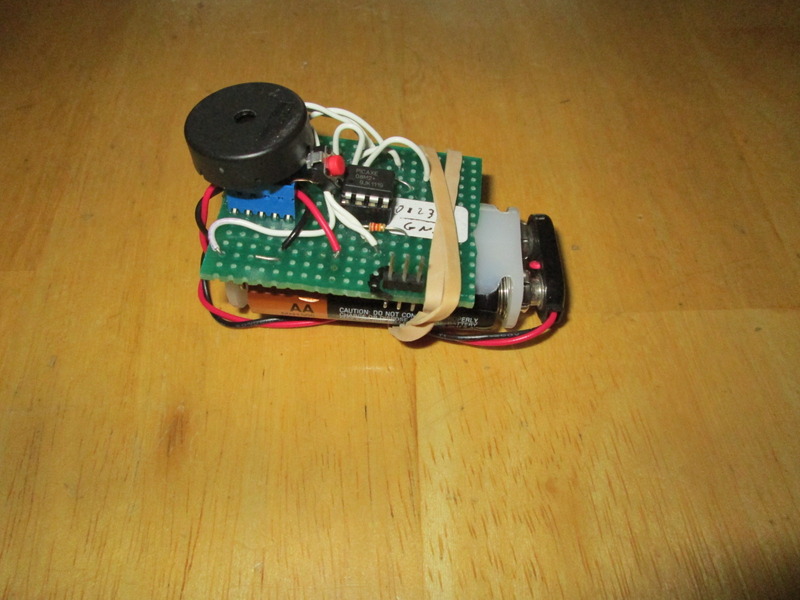| Picaxe Simplest Clock
|
After creating the simplest nightlight possible (but with very neat functionality) using just a single PICAXE 08M2 chip and an LED, I became intrigued by what else I could do with a minimum of components. A clock using a single-bit input and single-bit output seemed like the natural progression. Sure, an accurate clock using a DS1307 as a timebase, and a few pushbuttons for input would be a good build an afternoon, but the limitations of just a bare PICAXE were too tempting to resist. And here is where I started to sink way too much time into this project. There is a reason that real-time clock chips exist, and there is also a reason that electronic interfaces almost always have more than a single bit for input and output. But read-on if you must... Here it is: a fully functional timepiece, complete with Westminster quarter hour chimes (during the daylight hours only), active calibration, and a reasonably functional time-setting mechanism (considering there is only a single pushbutton and piezo present for I/O), using only a PICAXE, button, and speaker. In this design, I use the TIME function on the 08M2 to count seconds. Unfortunately, a 16 bit word can't hold the 86400 seconds in a day, so we have to have an AM/PM flag. And this chip was never intended to be an accurate time base. It's temporal accuracy will vary by manufacturing, voltage, temperature, and probably a few other parameters. In my rudimentary tests, my PICAXE 08M2 driven by 2.6 volts (2 somewhat dead AA batteries) at 70 degrees F loses about 20 minutes/24 hours. Not very good, as this ends ups losing well over a few hours each week. A timeskew of approximately +35 seconds/hour corrects the time drift quite nicely, but we can't simply add/subtract some seconds, because the internal resonator of the PICAXE is likely to drift over time, and each implementation will need a custom calibration. That's why his program provides a straightforward method of active calibration to greatly improve accuracy. After the clock is set(we'll get to that in a minute), pressing the button at the exact change of hour (as determined by an accurate external clock) calibrates this clock's measured time change with the actual time change that occured. From this, the timeskew is calculated and appied. Here's the concept behind setting/calibrating the clock with a single button (and a minimum of pain):
The UI took some thought to design. What is the best way to perform input and output using a single bit? I'm sure that there are much better ways to build a user-interface with a single-bit input and output, so please email me if you have something truly ingenious in mind. That's the thing about software, it can always be improved with more time and some imagination. To set the clock:
Congratulations, your 1-bit clock is now set to the current time.
The following schematic/layout drawing was
generated from this file
using PEBBLE
(Picaxe Electronic Bread Board Layout Emulator - V3.1). Parts count:
My schematic is above, and here is the
code (500 Lines, approximately 850 bytes, and plenty of comments).
My style/documentation is pretty rigorous, but I strongly advocate good
coding practice regardless
of the machine; all software only becomes more obfuscated over time. And if you're still reading, and perhaps even thinking
of building this clock, I should note that while it is a fun project,
my patience to improve the accuracy starting wearing thin after a
while. Perhaps it was the inability to set/correct the time
except exactly on the hour, that became tedious. Or perhaps it
was just the realization that clocks are ubiquitous in modern life, and
that a clock that is off by more than a few minutes quickly loses its
value. Regardless, I now have a great appreciation both for
mechanical timepieces which can keep time to within a few seconds per
day, and for our modern-day lifestyle, in which we have an expectation
that anyone, anywhere, can make arrangements to meet someone else with
an accuracy right down to minute, if not down to the second.
This code is explicitly released under the GPL. And this page is licensed under a Creative Commons Attribution 2.5 License. Write me if you find this project interesting. Link to this page if you find it relevant.. Warning, may cause loss of time. This project is
provided without any warranty and probably isn't suitable for anything. Read
or write a comment on the hardware projects |

